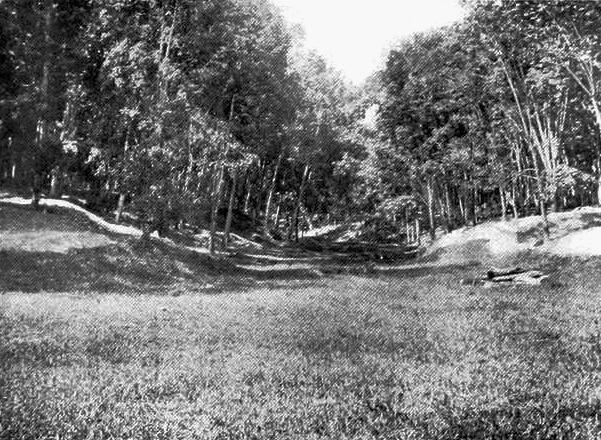| 13 |
Seafield Estate and subsoil drainage |
| 13.1 |
A grave problem |
The two previous chapters have been a digression, but not unintentional. From them the reader will have learned how grave a problem confronted estates situated in the Coastal Hills. They were in the forks of dilemma; if their ravines were left in jungle, they got malaria from A. umbrosus; if their ravines were cleared, A. maculatus would replace A. umbrosus, and take up the role of carrier. However scrupulously free from grass and weeds the ravine streams were kept, A. maculatus could not be driven out. Quinine given for years in large doses had proved a broken reed. What, then, could be done? Although, at this time, the elimination of malaria by control of mosquitoes was almost universally regarded as impracticable even for small towns, and for rural areas had not been discussed or suggested even in a tentative way, except by Ross himself, the ease with which it had been driven from the Coastal Plains and mangrove swamps, when the conditions there were made unsuitable for the Anopheles, had convinced me that an attack on the ravine Anopheles was the right policy.
At that time I knew of no method of oiling or poisoning or polluting the water which promised success in rapid streams; and I could think of nothing as suitable as a scheme of subsoil drainage. By carrying off all the springs and streams of the ravines in underground pipes, no water would be left for A. maculatus to breed in; and presumably, if a large enough area were done, malaria would disappear. But what was a large enough area, and how were pipes to be laid in the ravines so that they would drain the springs and streams; yet resist the tremendous scouring action of tropical storms?
| 13.2 |
The area to be drained |
The proposal was that all land within a circle of a certain radius should be drained and freed from the breeding places of A. maculatus; in the centre of the circle would be housed the labour force. There was little evidence of the distance that A. maculatus carried malaria from its breeding places; certainly nothing comparable with spleen rates of children in relation to flat land jungle; and these might mislead, if applied to hill land. The measurements on flat land were made in places for the most part with jungle on one side; from one direction only A. umbrosus attacked. What would the malaria and the spleen rates have been had the observations been made on estates consisting of small circular areas carved out of, and completely surrounded by, the jungle of the Coastal Plains? Into such areas A. umbrosus would have flown to the centre from every point of the compass; and spleen rates would have been of great value from the standpoint of the scientific sanitarian. But the information was not available; estates were not developed so as to produce these conditions.
There were two other considerations to be weighed. Into the hill land sanitary circle, which it was proposed to create, A. maculatus would not fly from all points of the compass. In hill land part of the circle would be low ground and ravines, which would breed mosquitoes; but another part would be high ground, which would be harmless. The proportion between the two would vary, depending on the number and extent of the ravines within the circle. The mosquito attack on the centre might be likened to a series of columns invading along the lines of the ravines, rather than to a diffuse cloud of insects flowing in from every part of the periphery of the circle. If this were so, then it would follow that the area to be drained must be larger, the greater the number and acreage of the ravines within the circle and on its periphery; and smaller under the opposite conditions; but no mathematical formula correlating the two factors could be devised until practical experience of a completed scheme gave us some knowledge of a third factor—the malaria-carrying power of A. maculatus under such conditions.
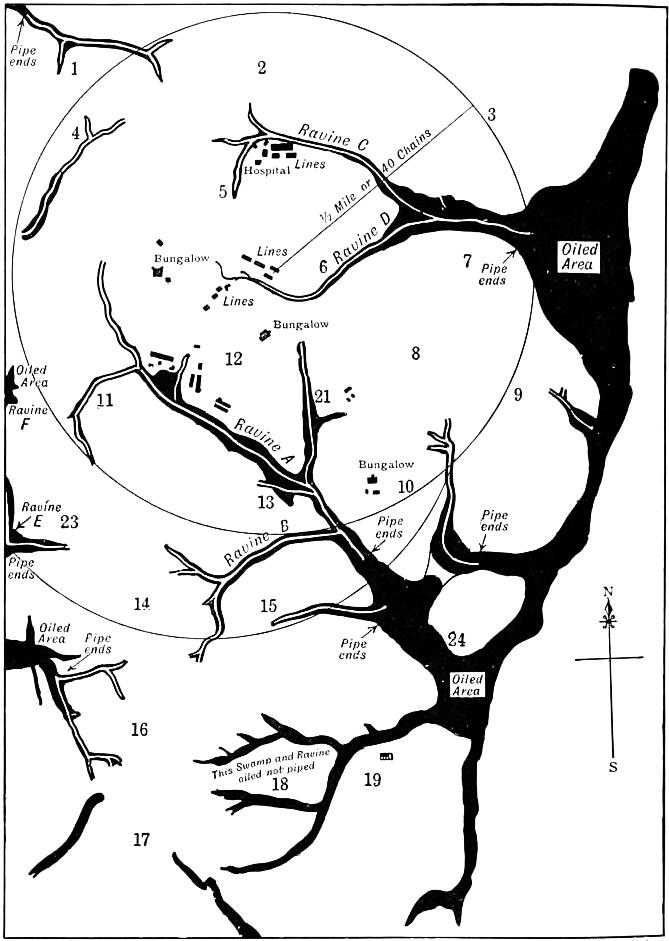
The information required was not merely how far A. maculatus could fly; what was wanted was a knowledge of how far it could carry malaria. It was immaterial if some mosquitoes could fly or be blown one mile or ten miles from their breeding place; but it was important to know how far the insect could fly in such numbers that malaria would remain as an endemic disease. On the flat land the spleen rates were found to fall progressively, the further the children were from the jungle home of A. umbrosus; until, at a distance of half a mile, the spleen rates were nil. Would the circle in the hill land require a radius of half a mile? A. umbrosus is a strong flier, and fierce biter; it will attack at any time of the day in heavy shade, either in the jungle or in a house. A. maculatus is relatively a delicate mosquito, dying quickly in captivity, and rarely, if ever, attacking during the day. Would it fly as far as A. umbrosus? That was a question we could not then definitely answer.
Where so much was uncertain, it was decided to begin with a circle of about 20 to 25 chains,28 and if that led to improved health we could afterwards enlarge the circle until malaria had entirely disappeared. This procedure would not only be of assistance in determining exactly how large the circle must be; but, on financial grounds, it was sound. To increase the radius of the circle from 20 to 40 chains was to quadruple the area, and would probably more than quadruple the costs; for the farther the ravines run, the larger they become, and the more costly their subsoil drainage would be. Where the cost even of a small experiment was to be considerable, it was important to avoid unnecessary expense; and, since proceeding by stages would give the maximum information with the minimum risk of wasting money, it was the policy I advised.
| 13.3 |
The engineering problem |
Seafield Estate consists of a series of small hills, part of the granite upheaval. The granite outcrops at a number of points in the ravines; but for the most part the rock is covered by deep, rich, friable red soil. In a number of ravines, however, the recently decomposed granite has become exposed; and there the ground consists of a mixture of fine white clay, kaolinite from the feldspar of the granite, infiltrated with grains of sand and particles of white gravel, the quartz of the granite. This white clay is practically impervious to water; so springs and seepages are abundant in ravines which contain it; and some Old Seafield ravines are largely like this. Where most of the white clay had been washed away, the sand and gravel were left in a mixture which has about as much stability as “porridge”; that was how Mr. Norman Grieve described it.
Down these ravines torrents of tropical rain pour; frequently one or two inches fall in an hour or less. Twenty inches might fall in a month; there might be twenty wet days in a month. In the steeper parts of the ravines, the once narrow drains had been scoured into wide, deep, uneven channels; in the flatter parts, the drain was obliterated by the silt from above, and the whole ravine converted into a wide swamp. In such ravines, and under such conditions, the new system of subsoil drainage was to be tried. The ancients had employed subsoil drainage in agricultural land; but the method of using it to control mosquitoes in hill streams and ravines, which I now proposed, was, as far as I am aware, new. The idea first came to me when reading Howard’s account of malaria in Central Africa, in which he states that the cost of lime is £6 per ton, and of English cement, £17 per ton. On my arrival in England in 1908, I made inquiries into the method of agricultural drainage, and bought some books on the subject. On returning to Klang in October 1908, I discussed the subject with the Chairman of the Klang Sanitary Board, the late Mr. J. Scott Mason, and Mr. John Gibson, General Manager of the Tremelbye Rubber Company, who was familiar with subsoil drainage in Scotland. It was decided to try it on one of the hill-foot drains in Klang. A Chinese roof tile maker was approached, and after several attempts he succeeded in turning out about fifty very respectable-looking tiles, and agreed to make more at a cost of two cents each. These were the first subsoil agricultural pipes made for anti-malaria work in the F.M.S.
Then appeared Mr. Sime’s paper in the Liverpool Annals of Tropical Medicine, from which it appeared that a system of subsoil drainage had been adopted in Panama with success some two years before. Although it differed in some important points from what I proposed, we decided to take no further action in Klang at the moment, as the special problem in hill land had come into view.
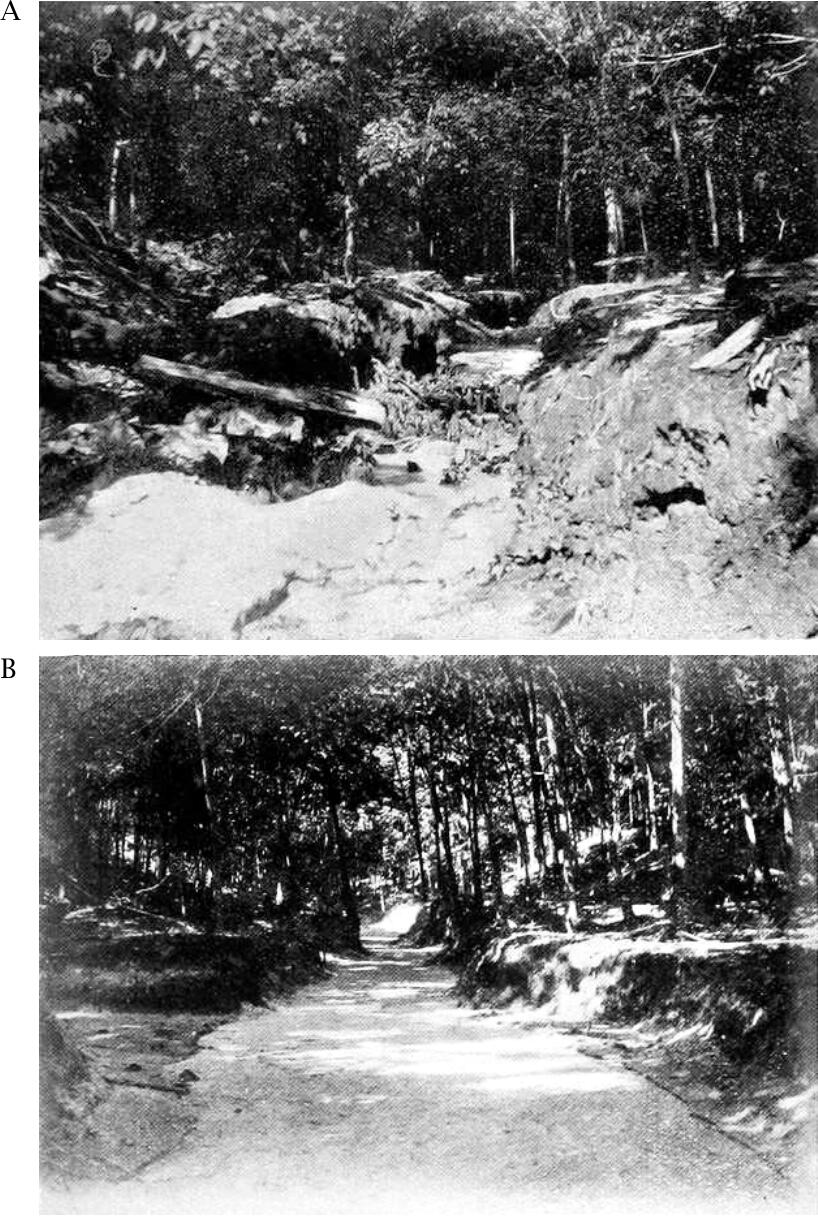
When convinced that A. maculatus in hill land could not be controlled by ordinary agricultural methods, I turned to the idea of drying the beds of the ravines by a system of subsoil drainage. It seemed likely, too, that by this drainage silt would be retained in the upper portion of the ravines, and would not cover the outlets of the subsoil drainage system in the lower portions. The ravine soil, consisting of porous silt and gravel, was to cover the pipes to a depth of three or more feet; it would allow seepage water, and some of the storm water to pass through it to the pipes, but would, so to speak, filter out any silt descending from the higher land, and retain it on its surface. The depth of the soil over the pipes would gradually be increased, but that would be no disadvantage. The deeper the soil over the pipes, the deeper the dangerous seepage and springs would be buried, and the less chance would there be of storms scouring out the pipes.
The powerful erosive action of storm water also required consideration. The pipes could be buried under a heavy layer of stone of graduated size with the smallest on the top. But it appeared to me essential, if we were to keep the silt from reaching the pipes in quantity and blocking them, that nothing less than a fine filtering layer composed of silt itself must be the top layer: and if the top layer, which would bear the brunt of the storm waters’ action, must be a fine soil, stones under it would not be required from an engineering point of view, and so would be unnecessary and expensive.
It was, therefore, decided not to lay stones over the pipes, but to break the power of the water by widening the storm water channel. This method differs from that employed in Panama, where earth is not put over the stone. “The dirt from the trench must be placed on the downhill side of the line, to prevent it washing back into the ditch. When the soil uphill from the ditch is covered with vegetation, the space between the cover stones does not fill up”—so Mr. W. Prince describes his method. When in Panama, I found that the soil was not friable or sandy like that in the F.M.S. The Panama system, although suited to that country, is quite unsuited to ravines in the F.M.S.; indeed, a modification of it was tried in Kuala Lumpur and proved a failure, as we shall see.
A system of open concrete drains in our ravines would have been useless. They would have been scoured out in the steeper portions of the ravines, and silted up in the lower. In Kuala Lumpur they were tried, and failed for these reasons (Figure 13.4).
| 13.4 |
The scheme approved by the directors |
From 1905 to 1908 the ravines on Seafield Estate had been kept free from all grass and vegetation with the idea of eliminating A. maculatus. Mr. H. R. Quartley took the keenest personal interest in the matter; and the failure to eliminate the mosquito was not for lack of care.
Nor had quinine been given to the labour force in any perfunctory way. Mr. Quartley realised that the success of the estate depended on a healthy labour force, and anything he undertook to do to improve the health was done thoroughly. Quinine was given at the muster, and no coolie received “a name” for his day’s work until he had swallowed the quinine. We saw the health improve, and the death rate come down; but a healthy labour force could not be built up. All new comers suffered from malaria; only a small proportion became immune; the others left the estate or died.
The failure of quinine to eliminate the disease was definitely established, and accepted by Mr. Quartley and myself in 1909; nothing more could be expected from clean weeding the ravines; nor would anything have been gained by abandoning them to revert to jungle. Our only hope appeared to lie in subsoil drainage; we discussed this. It appealed to Mr. Quartley; and he placed it before the directors, giving it his strongest support. He pointed out how it had been impossible to build up a healthy labour force; how, despite everything that could be done, the death rate of the labourers was so high that it could not be allowed to continue; how Europeans as well as Asiatics suffered, and proper supervision of estate work was difficult, if not impossible; and that if the estate could be made healthy at any reasonable cost, the expenditure would soon repay itself.
Owing to his urgent representations, the directors deputed one of their number, Mr. Norman W. Grieve, to visit the estate and decide whether or not to proceed with the scheme. Pending his arrival, Mr. I. Irvine, M.I.C.E., in 1910 made a survey of the ravines, and prepared plans and estimates. In 1910, at a meeting held at Seafield Estate, Mr. Grieve, on behalf of the Board of Directors,29 sanctioned the scheme. Mr. Bach, M.I.C.E., was engaged to carry out the work. He arranged for a Chinese roof tile maker to make the pipes; and the first pipes were laid on 1st June 1911 on Old Seafield.
| 13.5 |
A. maculatus as a natural carrier of malaria confirmed |
The announcement that A. maculatus would not disappear without special measures to exterminate it, and that unless measures were taken hill areas would remain permanently intensely malarious, naturally caused anxiety to the planting community. Hitherto the hills had been regarded as a refuge from malaria whose home was supposed to be swamps and flat land, especially near to the coast. So it was in Italy, from which country most of our ideas of malaria had come. But in Malaya my observations had cut away all ground for hope of improvement in the hill-land estates, and I received numerous letters on the subject.

The Directors of Seafield Estate had decided to proceed with the work on my advice, but I felt it would be more satisfactory to them if my findings were confirmed by a competent scientific observer. Accordingly I asked Dr. A. T. Stanton, of the Institute for Medical Research, if he would be good enough to visit Seafield Estate to check my observations; and, if he confirmed them, to give me a letter which I could send to the Directors of Seafield Estate, and to any other companies that might be interested. This Dr. Stanton kindly consented to do; he visited the estate, and sent me the following letter:
Very many thanks for your courtesy in giving me an opportunity to test the accuracy of your observations with reference to the malaria-carrying mosquitoes of hill estates.
As I have already written, I was able to confirm the finding of zygotes in the stomach wall of N. willmori30 by the examinations of specimens taken in Kuala Lumpur, and our finding of sporozoites in the salivary glands of specimens taken in the coolie lines of a hill estate proves the accuracy of your original observation that this species is a carrier in nature.
The number of N. willmori taken in the lines, and the readiness with which we were able to demonstrate the parasite in them during a period, when, as the manager informed us, the estate was comparatively free from malaria, is ample evidence of the importance of this species in the spread of malaria in hill areas.
I was greatly interested in your demonstration of the breeding places to which you refer in your book. My own more limited experience of the breeding places of anophelines would have led me to doubt the likelihood of finding larvae attached to small stones in a stream of considerable volume and current free from grass and other vegetation. The fact that we did find them in those situations as well as in large numbers in small pools in sand at the side of the streams shows the very great difficulty likely to be experienced in freeing these areas of malaria.
I hope you will be successful in the measures you have proposed, and I may perhaps be permitted to congratulate you again upon the very important additions you have made to our knowledge of malaria, the most important disease problem, as I believe, which confronts sanitarians in this country.
Yours sincerely, A. T. Stanton
Institute for Medical Research,
Kuala Lumpur, 27th June 1911.
| 13.6 |
Progress of the Work—Old Seafield, or Southern Division |
The first ravine to be drained was one of the steepest, and its soil specially friable. What appeared to be an ample storm-water channel was made; and for several months the work remained intact despite considerable rains. But during the very heavy and continuous rains of December scouring occurred, and it was evident that a wider channel was required.
With characteristic thoroughness Mr. Quartley decided to provide the maximum security for the pipes; he swept away all rubber trees from, “filled in,” and “barrelled” the bottom of the ravine, so that the stream water no longer acted chiefly on the line of the pipes. It was spread over the whole ravine, and rather on the sides than the centre.
By April 1912 such progress had been made that all ravines within 25 to 28 chains of the coolie lines had been drained. It did not, however, include the large ravine, B (cf. Figure 13.1). The area was not completely free from breeding places; wherever white clay had been exposed, seepage water poured out, until secondary lines of pipes finally cut it off. Some wells also remained in connection with the water supply. As all the engineering problems had been solved, and already the health of the labour force had improved, it was decided to extend the area to 40 chains from the lines.
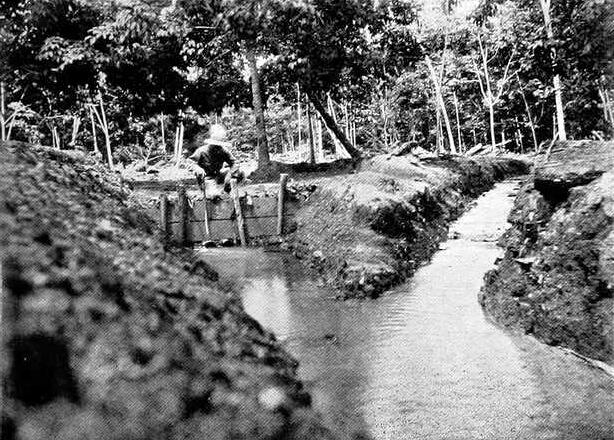
The new area taken in consisted of the lower and flatter portions of the ravines, and, although an increased sectional area of pipes was laid down, it proved insufficient to discharge the water quickly enough in the wet weather at the end of the year. Water, therefore, appeared on the surface of the upper parts of the ravines, which had been dry in 1912, just as if drains were blocked. One of the disadvantages under which the estate worked was the impossibility of calculating the sectional area of the pipes required to drain a ravine. No pipes larger than 8 inches in diameter were obtainable; and it was only by observing the results in wet weather that the right number of lines of pipes could be determined.
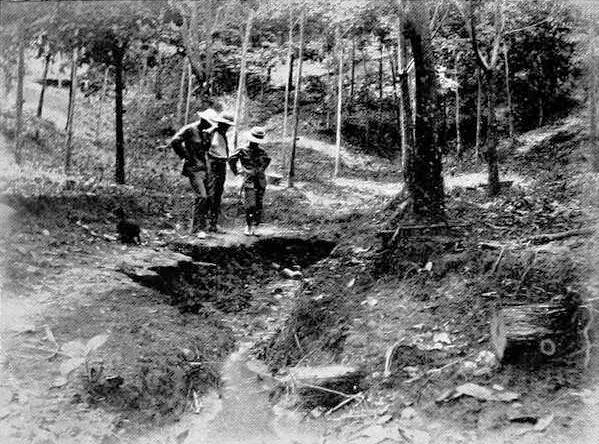
In 1914 two additional lines of pipes were laid down in Ravines C and D; and in 1915 in Ravines A and B. So that it was the end of 191531 before Old Seafield had the advantage of drainage area of a 40-chain radius, everywhere except in one direction, namely, in Ravines E and F.
| 13.6.1 |
New Seafield, or Northern Division |
In January 1914 work was begun on the New Seafield Division, and by the end of the year had been carried out for 26 chains in one direction and 16 chains in the other. The whole area was completed by the end of 1915. Profiting by the experience gained on Old Seafield, the sectional area of the pipes was ample, and the ravines have been dry since they were drained.
All wells were closed as soon as the pipe water supply was laid on in 1913, as A. maculatus and A. umbrosus breed in them. It was necessary, however, to keep the main water supply, which comes from a reservoir in a branch of the head of ravine A, situated close to the coolie lines and two bungalows on Old Seafield. From time to time larvae would be taken in this water; but so seldom as to appear negligible. Algae grew on the bottom of the reservoir; in dry weather portions died off and floated to the surface. To ascertain to what extent this reservoir was a breeding place, about a quarter of the floating debris was skimmed off, placed in a large jar, and treated with a strong solution of copper sulphate. The algae quickly shrivelled and sank to the bottom, leaving only small fragments of twigs and leaves. On searching this carefully, forty-nine larvae were found, of which thirty-six were A. sinensis (which I do not regard as an important carrier of malaria); ten were A. umbrosus; and three were so small that they could not be identified with certainty, but were probably A. umbrosus.
In view of this observation, it seemed advisable to control the reservoir as a breeding place. Oil could not be applied; but copper sulphate is added each week, and has greatly diminished, although it has not entirely killed out the sign.
